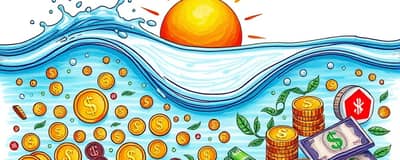Managing personal cash flow is more than balancing numbers—it’s about reclaiming control of your life, reducing stress, and paving the way to long-term dreams.
What Is Personal Cash Flow?
Personal cash flow refers to the movement of money into and out of your personal finances, including income, savings and spending. Understanding this cycle is the first step toward building a more secure financial future.
At its core, cash flow management ensures that your outflows (expenses) never exceed your inflows (income), so you can avoid debt traps and create opportunities for growth.
Why Managing Cash Flow Matters
Whether you’re saving for a home, preparing for retirement or simply want peace of mind, good cash flow habits are indispensable. When you master this skill, you can:
- Anticipate cash shortages before they become crises
- Reduce financial stress and prevent late fees
- Allocate resources toward long-term goals confidently
- Maintain steady stream of savings and growth
Calculating Your Personal Cash Flow
Accurate numbers are the backbone of any sound plan. Follow these steps each month:
Step 1: Determine Monthly Net Income
Include your take-home pay after taxes, plus reliable sources such as rental earnings, side gigs, dividends or interest.
Step 2: Record All Expenses
Separate fixed expenses—rent or mortgage, insurance, loan payments—from variable costs like groceries, transportation and entertainment. For accuracy, average variable expenses over three months.
Step 3: Subtract Expenses from Income
The result is your cash flow. A positive number means a surplus; a negative figure signals overspending and potential trouble.
Budgeting Tools and Methods
Choose tools that match your style and discipline level. Popular options include:
- Mint and YNAB for interactive budgeting apps
- Custom spreadsheets for complete flexibility
- Living expense worksheets and planner templates
- QuickBooks for advanced users with business needs
Once you have a tool, pick a method. The 50-30-20 rule is a favorite:
• 50% of income on essentials (housing, utilities, groceries)
• 30% on wants (dining out, hobbies, subscriptions)
• 20% on savings and investments (emergency fund, retirement accounts)
Feel free to adjust these percentages, but keep your savings allocation a top priority.
Strategies to Boost Your Cash Flow
- Reduce recurring expenses by canceling unused subscriptions and negotiating lower rates
- Increase income through side hustles, freelancing, or asking for a raise
- Automate finances: set up direct deposits, scheduled bill payments, and automatic transfers to savings
- Review spending patterns quarterly to spot leaks and opportunities
Implementing even one of these tactics can create immediate relief in your monthly budget.
Building an Emergency Fund
Life’s unexpected events—job loss, medical emergencies or urgent car repairs—can derail your finances if you’re unprepared. Aim to save three to six months of living expenses in a separate, easily accessible account.
Start small: commit a fixed amount each week or month. Celebrate milestones—reaching $1,000, then $2,500—until you hit your ultimate target.
Planning for Future Goals
Beyond emergencies, you may aim to buy a house, fund your child’s education or travel the world. Use annual cash flow projections to:
• Anticipate inflows and outflows
• Identify potential shortfalls months in advance
• Adjust your budget in real time to stay on track
Document each goal, assign a timeline and cost estimate, then incorporate those figures into your monthly cash flow plan.
Recognizing Warning Signs and Avoiding Mistakes
A few consecutive months of negative cash flow, increasing reliance on credit cards and spiraling debt are red flags. To course correct:
• Factor in seasonal variations (bonuses, holiday spending)
• Track every dollar—no expense is too small to record
• Review and adjust your budget at least quarterly
Core Concepts at a Glance
Empower Yourself with Professional Support
If you feel overwhelmed, a certified financial advisor can provide personalized guidance, uncover hidden savings opportunities and hold you accountable. Numerous online calculators and tutorials also offer step-by-step assistance.
Conclusion
Mastering personal cash flow is an ongoing journey, not a one-time task. By calculating accurately, choosing the right tools, and implementing targeted strategies, you can transform stress into confidence.
Remember, every dollar you track brings you closer to living a life free from financial worry and empowers you to pursue your wildest dreams. Start today, stay consistent, and watch your financial resilience grow.
References
- https://teamhewins.com/personal-cash-flow-management/
- https://www.nerdwallet.com/ca/personal-finance/what-is-cash-flow
- https://www.finra.org/investors/personal-finance/control-spending-calculate-cash-flow
- https://bogartwealth.com/personal-cash-flow-statement/
- https://bettehochberger.com/quickies/your-cash-flow-management-guide-7764/
- https://www.investopedia.com/investing/what-is-a-cash-flow-statement/
- https://turningpointhq.com/personal-cash-flow
- https://www.gsquaredcfo.com/blog/cash-flow-101-tips-for-management-projection-and-long-term-improvement














